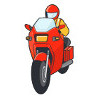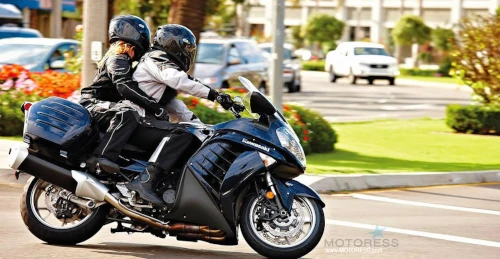 Riding 2-up can add greatly to the enjoyment of riding a motorcycle. Many couples make this their favourite holiday excursion. You will typically see them on larger touring models that are built for carrying passengers and their cargo comfortably and safely. You will also usually see the passenger dressed just as well as the rider, which is as it should be. But casually carrying a passenger isn’t always a great idea.
Riding 2-up can add greatly to the enjoyment of riding a motorcycle. Many couples make this their favourite holiday excursion. You will typically see them on larger touring models that are built for carrying passengers and their cargo comfortably and safely. You will also usually see the passenger dressed just as well as the rider, which is as it should be. But casually carrying a passenger isn’t always a great idea.

Rider's Responsibilities
Some riders aren’t aware that it is their responsibility to ensure their passenger meets all legal requirements for a properly fitting helmet. If you’re going to carry a passenger regularly you need to make sure they are as well prepared as you are for the weather and the road hazards; such as boots, riding jackets and pants, eye protection, gloves and rain gear. Otherwise, this might be the last trip you take together.
Some Motorcycles Are Not Designed for Passengers
Not all motorcycles are designed to carry passengers. For example, mopeds are not legal for carrying passengers, and motorcycles under about 250 cc don’t have adequate power for safe operation in traffic with a passenger. The additional weight of a passenger will reduce acceleration, but they will also reduce the braking capacity. You have to be able to get up to speed in traffic and also reduce speed quickly to stay safe.
Downhill braking is twice as challenging as the front suspension compresses, reducing stability. A heavy passenger also compresses the suspension enough to reduce cornering clearance, requiring slower cornering speeds.
There has to be a seat large enough for a passenger, plus foot pegs. Passengers have to have legs long enough to reach the foot pegs, which means younger riders aren’t ready until they’ve grown enough.
You cannot carry a passenger in front of the rider, either.
Passengers Must Know What To Do
Passengers also need to be trained to keep both of you safe. A passenger moving the wrong way at the wrong time can literally cause a loss of stability resulting in a crash or a collision. If your passenger or you are not experienced, you should go to an empty parking lot for some practice before you hit the road.
The passenger should get on after the rider has braced him/herself and the machine, with the brake applied to prevent rolling. At the end of the ride, the passenger should again dismount only when the rider says he/she is ready. Once mounted, the passenger should be holding on to something – grab rails or the rider and their feet should stay on the pegs until the end of the ride.
As the motorcycle must lean to go around curves, the passenger needs to be aware of that and be comfortable with it. The passenger should simply keep his/her body in the same posture as the rider and ‘go with the flow’. The worst thing is for the rider to lean the motorcycle to one side and the passenger to lean to the opposite side.
Practice in a Safe Place
In the parking lot simply practice smooth acceleration from a stop and smooth braking to a stop. Then practice smooth curves, first at slower speeds and then a bit more quickly than a walking pace so the passenger can feel the motorcycle’s stability. Work your way up to large circles, in both directions.
When the rider and passenger are both comfortable with the process, you can proceed onto the road, but start out with lower-speed roads and shorter rides. It could be a long walk home for someone and a challenge to the relationship if you don’t take this process seriously. Scaring your passenger is simply no way to impress someone, and it could be dangerous for both of you.
A final caution... if you are thinking about becoming a passenger consider the above thoughts. Ask about the experience the rider has carrying passengers and get some practice before hitting the road. Riding together when properly prepared can be a wonderful experience for both the rider and the passenger.
Originally published in the South Shuswap Scoop
Learn More
Share This Article
- Log in to post comments
